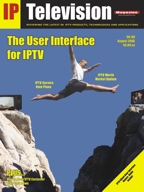Our mission is to identify and explain the technologies and applications that allow television services to be provided through Internet Protocol (IP) data networks. Readers learn the options and the system to implement IPTV along with new features and applications and business opportunities that are available in the IPTV industry today.

IP television is the transmission of television (digital video and audio) through data networks such as DSL, cable modem or wireless broadband. IP television services may be on a subscription basis (paid for by the recipient) or may be funded by commercials or government agencies. IP television broadcasters transmit multimedia data signals to end users or they can send the media to multicast distribution points that redirect the digital television signals to end users.
IP Television magazine explains how and why people and companies are using IP television and Internet television services. You will discover how global television services are already available through managed broadband networks (DSL and Cable modem) and unmanaged networks (the Internet) and how it is possible to use standard television to watch global television channels using analog television adapter boxes.
Through IP Television magazine, you will discover how IP television (IPTV) can be watched on different types of viewing devices such as standard televisions with digital media adapters, Smart TVs, multimedia computers, and mobile telephones.
IP television service allows viewers to have more control of television services. This control ranges from instant service activation to real time television on demand controls. Some of the advanced Internet television features such as personal media channels, anywhere television extensions, global television channels and multimedia programs are described.
In addition to the traditional ways of television channel selection, you will learn about new ways television channels can be search and selected using interactive electronic programming guides (EPGs). The different types of media formats that are used for IP television services are explained along with their control protocols.
Not all IP Television systems and services are the same. There are cost and quality tradeoffs along with common problem areas and risks. You will discover how the audio and video service quality can range from poor to above the quality that is already delivered to standard TV.
Because each IP television viewer has a unique address, this allows advertising messages to be sent to specific viewers (addressable advertising). The ability to direct advertising messages to specific target audiences is more valuable to companies than traditional broadcast advertising and this may result in reduced viewing costs.
Some of the most important topics covered in the magazine are:
- Fundamentals of how IP Television works
- How to use regular televisions to watch IP TV
- Global television channels
- Internet television service quality
- The costs of IP Television
- Control of Internet television services
- Internet television service providers
- Advanced Internet television features
- Electronic programming guides
- IP television Media formats
